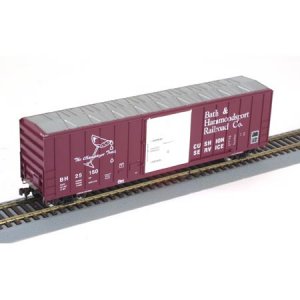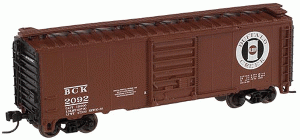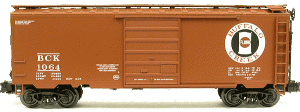ALL:
Boxcar loads don't get much attentions because, well, we can't see them. However, over time I've compiled quite a list of items that were or still are shipped in boxcars. I think you'll find them interesting.
DougC
RAILROAD BOXCAR LOADS - ABOUT 1930 INTO THE 1970's
1. Ammunition
1A. Automobiles - shipped in Auto XAR boxcars
1B. Automobile parts – from parts manufacturers to auto assembly plants
1C. Automobiles - shipped LCL (Less Than Carload - railcars are setout at two or more receivers)
2. Appliances
3. Bags (loose or palletized)
3A Commodities: Flour, Rice, Beans etc etc stacked or palletized
3B Boxes (with or without pallets) of hardware items
4. Barrels, Drums or Kegs
5. Batteries - Storage
5A. Beverages
6. Bricks and Hollow Building Tile
7. Brick - Hop Top (I don't know what this is; do you?)
8. Bulk loose items like grain, ore and coal by puting temporary wood “doors” inside the railcar doorways
9. Cable on Reels and Wire Commodities
10. Car Doors
11. Car Wheels - Loose
11A. Coil steel products
12. Cylinders - Empty, With or Without Caps
13. Fiberboard Containers
14. Freight – general (including mail-order items from Sears, etc. for such things as washing machines, etc.)
15. Furniture - Car Load
16. Furniture – LCL (Less Than Carload)
16A Georgia kaolin clay, loose, loaded through hatches on the roofs or thru the doors in bags on pallets
17. Grain and grain products in fiberboard containers or sacks or loose (with or without grain doors added)
17A Hoboes and migrant workers
18. Ink and like commodities in six-gallon pails
19. Livestock (in boxcars with slats for sides - i.e. stock cars)
20. Lumber
21. Machinery
22. Marble Slabs
23. Sheet Steel, Tin Plate and other steel products
24. Mixed Loads of Commodities in Wooden Cases, Cartons
25. Paper (rolls or stacked) and Similar Commodities on Skids/pallets; plus pulp, scrap paper, newsprint paper
25A People & troops - Troops: particularly during wars. People: such as Stalin in the 30s and 40s relocating 1.5 million people to Sibera and other areas
26. Plasterboard, Wallboard etc in Solid Loads or Bagged Commodities as Mixed Loads
27. Projectiles, Bombs and Cartridge Cases (Empty)
28. Radiators - Cast Iron
29. Vegetables, fruit, and butter in tubs – moved in boxcars cooled by ice or mechanical refrigerator – known as refrigerator cars
30. Roofing Materials-Prepared
31. Soda Ash and many other mined items mostly in large sacks
32. Stones - Pulp Grinder
33. Stoves and Ranges
34. Empty tanks
35. Untreated Cross Ties
36. Bulk Grain
37. Pig Lead, Copper Bars and Similar
38. Unsaturated Roofing Felt and Pulpboard Paper
39. Newsprint
40. Vitrified Clay Sewer Pipe
41. Rolled and Plate Glass
42. General LCL Less-Than-Carload freight
43. Loose rocks with value from mines - moving rough, highly valuable rocks (like silver from Colorado) to a processing plant
44. Other uses for boxcars - if wore out enough, turned into homes, home-extensions, motel lodging structures, and livestock shelters
Can any of you add to this list? Wachya think? Comments?
P.S. You know, a lot of these commodities could be made partially visible if the railcar doors weren't totally shut (this IS prototypical). I have a few cars like this in a couple of my freight trains - adds interest and sometimes questions.
Boxcar loads don't get much attentions because, well, we can't see them. However, over time I've compiled quite a list of items that were or still are shipped in boxcars. I think you'll find them interesting.
DougC
RAILROAD BOXCAR LOADS - ABOUT 1930 INTO THE 1970's
1. Ammunition
1A. Automobiles - shipped in Auto XAR boxcars
1B. Automobile parts – from parts manufacturers to auto assembly plants
1C. Automobiles - shipped LCL (Less Than Carload - railcars are setout at two or more receivers)
2. Appliances
3. Bags (loose or palletized)
3A Commodities: Flour, Rice, Beans etc etc stacked or palletized
3B Boxes (with or without pallets) of hardware items
4. Barrels, Drums or Kegs
5. Batteries - Storage
5A. Beverages
6. Bricks and Hollow Building Tile
7. Brick - Hop Top (I don't know what this is; do you?)
8. Bulk loose items like grain, ore and coal by puting temporary wood “doors” inside the railcar doorways
9. Cable on Reels and Wire Commodities
10. Car Doors
11. Car Wheels - Loose
11A. Coil steel products
12. Cylinders - Empty, With or Without Caps
13. Fiberboard Containers
14. Freight – general (including mail-order items from Sears, etc. for such things as washing machines, etc.)
15. Furniture - Car Load
16. Furniture – LCL (Less Than Carload)
16A Georgia kaolin clay, loose, loaded through hatches on the roofs or thru the doors in bags on pallets
17. Grain and grain products in fiberboard containers or sacks or loose (with or without grain doors added)
17A Hoboes and migrant workers
18. Ink and like commodities in six-gallon pails
19. Livestock (in boxcars with slats for sides - i.e. stock cars)
20. Lumber
21. Machinery
22. Marble Slabs
23. Sheet Steel, Tin Plate and other steel products
24. Mixed Loads of Commodities in Wooden Cases, Cartons
25. Paper (rolls or stacked) and Similar Commodities on Skids/pallets; plus pulp, scrap paper, newsprint paper
25A People & troops - Troops: particularly during wars. People: such as Stalin in the 30s and 40s relocating 1.5 million people to Sibera and other areas
26. Plasterboard, Wallboard etc in Solid Loads or Bagged Commodities as Mixed Loads
27. Projectiles, Bombs and Cartridge Cases (Empty)
28. Radiators - Cast Iron
29. Vegetables, fruit, and butter in tubs – moved in boxcars cooled by ice or mechanical refrigerator – known as refrigerator cars
30. Roofing Materials-Prepared
31. Soda Ash and many other mined items mostly in large sacks
32. Stones - Pulp Grinder
33. Stoves and Ranges
34. Empty tanks
35. Untreated Cross Ties
36. Bulk Grain
37. Pig Lead, Copper Bars and Similar
38. Unsaturated Roofing Felt and Pulpboard Paper
39. Newsprint
40. Vitrified Clay Sewer Pipe
41. Rolled and Plate Glass
42. General LCL Less-Than-Carload freight
43. Loose rocks with value from mines - moving rough, highly valuable rocks (like silver from Colorado) to a processing plant
44. Other uses for boxcars - if wore out enough, turned into homes, home-extensions, motel lodging structures, and livestock shelters
Can any of you add to this list? Wachya think? Comments?
P.S. You know, a lot of these commodities could be made partially visible if the railcar doors weren't totally shut (this IS prototypical). I have a few cars like this in a couple of my freight trains - adds interest and sometimes questions.




